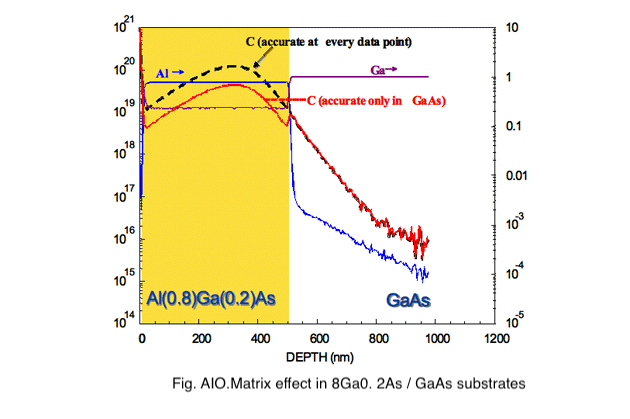What is the matrix effect?
Home » What is the matrix effect?
SIMS is a method for detecting ions (secondary ions) emitted from a solid surface by sputtering while continuously bombarding that surface with an energetic an ion beam (primary ions). The intensity of secondary ions depends not only on the concentration of the element, but also on the type and composition of the material (matrix). This is called the “SIMS matrix effect”.
For primary ion beams, chemically active ion beams (O2 +; Cs +) are used to obtain high sensitivity. The reason why the matrix effect occurs is that the ionization rate and sputter yield differ depending on the material. The ionization rate is roughly proportional to the oxygen concentration and cesium concentration injected into the sample surface, so even a slight change in sputter yield can change the intensity.

Since SIMS is a method that is affected by the matrix effect, a standard sample with the same composition as the analytical sample is used for accurate quantification. For example, in the compound semiconductor devices multilayer films are grown with different compositions. These different matrix compositions affect the elemental sensitivities and sputtering rates. Similarly, the outermost surface of Si materials, including the surface oxide film (SiO2), also has a changing matrix composition which changes elemental sensitivities and sputtering rates. In order to obtain a more accurate depth direction distribution, a method was developed at EAG for correcting the matrix effect. It is called Point-by-Point CORected-SIMS, ( PCOR -SIMS ).
Matrix effect of concentration distribution in C depth direction in AlGaAs / GaAs substrate.
The figure shows the ion implantation distribution of C in an Al0.8Ga0.2As / GaAs structure: 1) using only GaAs standard sample (solid line), 2) using GaAs standard sample with the PCOR-SIMS correction to account for the composition of the Al0.8Ga0.2As layer (broken line). In the case of 1), it can be seen that the C profile in the AlGaAs is displayed too low in the AlGaAs layer due to the effect of the matrix having Al in it. (See step at the Al0.8Ga0.2As/GaAs interface.) In case 2), the PCOR-SIMS correction has produced a smooth profile across the interface which is what is expected. In the case of multi-layer films of different materials, the concentration is usually determined from one standard sample, so the concentration is incorrect for materials (compositions) different from the standard sample. When viewing the data, it is important to note which standard sample material was used for quantification.
However, even if the material is different from the standard sample, if a comparison between unknown samples of the same material is desired, the accuracy of the relative comparisons will still be accurate because the quantification standard is the same. The absolute concentrations may be in error, but the relative concentrations between samples will still be correct, providing that the matrix composition between the samples is the same. In practical analysis, it is difficult to quantify all the layers accurately of a multi-layered film of dissimilar materials, so the relative comparison between samples is overwhelmingly often based on one standard sample.
Would you like to learn more about the matrix effect?
Contact us today for your matrix effect needs. Please complete the form below to have an EAG expert contact you.